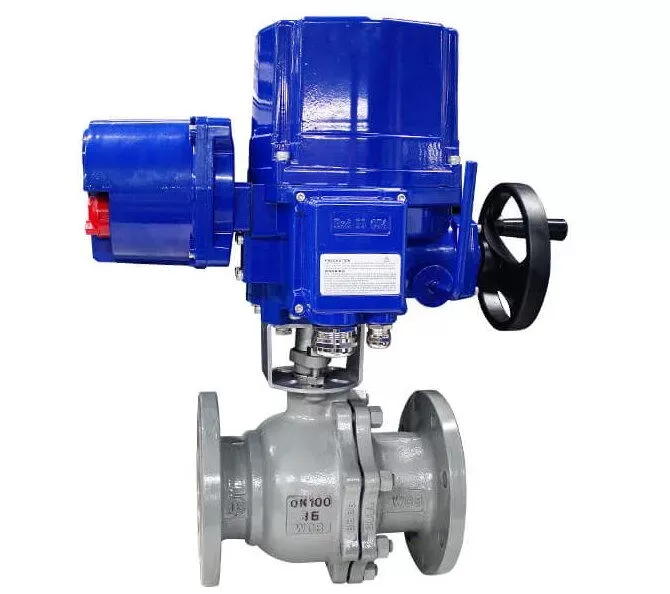Notifications

9 minutes, 23 seconds
-50 Views 0 Comments 0 Likes 0 Reviews

As a leading control valve manufacturer in China, we deliver high-quality valves and control actuators expertly designed to meet a wide range of industrial requirements.
In an age where automation and precision are pivotal across industries, the motorized ball valve stands out as a crucial innovation in fluid control technology. Whether managing sophisticated industrial systems or improving efficiency in residential setups, this electrically actuated valve offers a reliable and efficient solution for regulating the flow of liquids and gases.
But what exactly is a motorized ball valve, and where is it used? This article explores its working principle, real-world applications, and maintenance best practices, providing a comprehensive understanding of this essential device.
A motorized ball valve, also known as an electric ball valve, is a type of quarter-turn valve that uses an electric actuator to open or close the valve. At its core is a perforated, pivoting ball that rotates to allow or block the flow of a medium—such as water, gas, oil, or slurry—through the pipeline.
Unlike manual ball valves, which require human intervention, motorized versions are automated and programmable. This allows for remote control, timed operation, and seamless integration with industrial control systems like SCADA (Supervisory Control and Data Acquisition) or PLC (Programmable Logic Controller) networks.
These valves come in various sizes, materials, and configurations to suit diverse environmental and operational needs—from small residential water systems to high-pressure industrial applications.
Motorized ball valves are prized for several distinct features that make them ideal for automated flow control:
Fast and precise operation: The electric motor enables quick and accurate actuation.
Leak-proof design: The quarter-turn mechanism ensures a tight seal, minimizing leaks.
Remote and automated control: Easily integrated into building management or industrial automation systems.
Durability: Built to withstand harsh operating conditions, including corrosive media and high-pressure environments.
Low maintenance: Requires less upkeep compared to pneumatic or hydraulic valves.
Motorized ball valves find utility across a wide range of applications, from household appliances to complex industrial systems:
In residential and commercial heating systems, motorized ball valves regulate hot water or steam flow to radiators and underfloor heating circuits. By automating flow based on temperature sensors or schedules, these valves help maintain consistent indoor temperatures and improve energy efficiency.
In large HVAC setups, such as in office buildings or hospitals, motorized valves enable zoning—dividing a building into areas with individual temperature control—enhancing both comfort and energy savings.
Efficient water use is vital in modern agriculture. Motorized ball valves control water flow in drip and sprinkler irrigation systems. When integrated with soil moisture sensors and irrigation controllers, these valves operate automatically based on real-time data, reducing water waste and optimizing crop yields.
Advanced systems even allow farmers to monitor and control valves remotely via smartphone apps, improving operational efficiency and sustainability.
Industries such as chemical processing, pharmaceuticals, food and beverage, pulp and paper, and oil and gas rely on precise flow control. Motorized ball valves enable:
Handling hazardous or corrosive fluids without human intervention.
Operation under high pressure and temperature.
Automation of complex production sequences where timing and consistency are critical.
For example, in beverage manufacturing, these valves regulate ingredients like water, syrup, or CO₂ during bottling. In chemical plants, they safely and precisely control the mixing of reactive compounds.
Motorized ball valves are essential in water treatment processes like filtration, chemical dosing, disinfection, and sludge handling. Their automation reduces manual oversight, minimizes errors, and ensures continuous operation.
In smart homes, motorized ball valves automate plumbing for appliances such as washing machines, dishwashers, and water heaters. They can shut off automatically during specified times or upon leak detection, preventing damage and enhancing safety.
Commercial properties may also use these valves in backflow prevention, water metering, or emergency shutoff systems.
In fire suppression networks, including sprinklers and foam delivery systems, motorized ball valves regulate and isolate water or foam flow. Remote control of these valves enhances safety and compliance during emergencies.
Motorized ball valves offer various control modes:
On/Off Control: Simple open/close operations.
Modulating Control: Partial opening for precise flow rate adjustment based on signals (usually 0–10V or 4–20mA).
Fail-Safe Features: Return to a default position on power loss to enhance safety.
These valves integrate easily with building automation systems (BAS) and industrial control panels, using communication protocols such as Modbus, BACnet, or Ethernet/IP.
Available in multiple materials and configurations to suit applications:
Valve Bodies: Brass, stainless steel, PVC, bronze, carbon steel.
Seals: PTFE, EPDM, Viton, NBR based on chemical compatibility.
Connections: Threaded (NPT/BSP), flanged, socket weld, tri-clamp for sanitary uses.
Enclosures: IP65, IP67, IP68 for water resistance; explosion-proof options for hazardous environments.
Motorized ball valves are designed for low maintenance and long service life when correctly applied. However, routine inspection and preventive care are recommended:
Visual Inspection: Look for corrosion, leaks, or wear; check actuator mounting and clearance.
Seal and Gasket Replacement: Replace seals in abrasive or high-cycle environments to maintain leak-proof performance.
Electrical Checks: Inspect wiring and control signals for damage or corrosion.
Lubrication: Some industrial models may require periodic lubrication; use manufacturer-approved lubricants.
Testing and Calibration: Particularly for modulating valves, recalibrate as needed.
Environmental Protection: Maintain actuator seals and enclosures, especially outdoors or in corrosive areas.
Fail-Safe Verification: Regularly test fail-safe mechanisms to ensure proper function during power loss.
Consider these factors when selecting a valve:
Medium: Water, air, gas, chemicals, slurry.
Operating Pressure and Temperature: Match or exceed system demands.
Power Supply: Common voltages include 12V DC, 24V AC/DC, 110V AC, 220V AC.
Control Signal: On/off or modulating.
Certifications: NSF, UL, CE, ATEX for compliance.
Environmental Conditions: Corrosive, explosive, or underwater environments may require specialized valves.
Investing in high-quality valves from reputable suppliers ensures reliability, compliance, and long-term savings.
Motorized ball valves have revolutionized fluid flow management across countless applications. From home automation and agriculture to complex industrial processes, these valves combine precision, reliability, and efficiency.
Although low maintenance compared to other valve types, adhering to inspection and care best practices ensures longevity and peak performance. Whether upgrading or designing new systems, integrating motorized ball valves is a smart step toward modern, automated flow control.
For optimal results, consult trusted valve suppliers who can guide you in choosing the right model for your specific needs.Know more about Google SEO Directory

